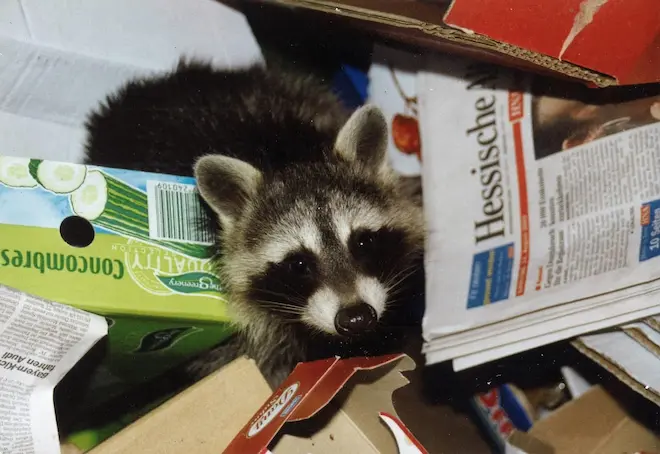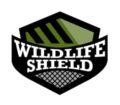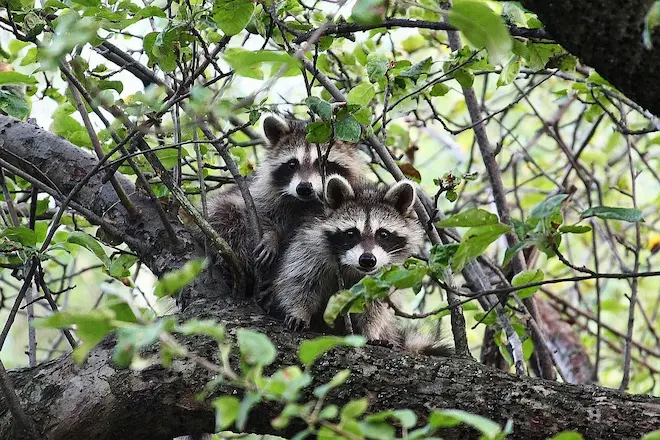Raccoons just like most mammals are excellent mothers; they take good care of their young ones. When raccoon babies are born, they stay in the nest while the adult female raccoons go out to forage for food to help them produce enough milk to feed their young. After about 12 weeks of nursing, the baby raccoons are finally old enough to follow their mother out of their nesting area. During this time, they will learn from their mother how to forage for food, and where to look.
Baby raccoons are dependent on their mother for up to nine months, after which they will go their way. The mother raccoons give birth to up to nine pups. After nine months she will only have two left, after which she will look for a new mate to make another litter during winter.
What do baby raccoons eat?
Raccoons are omnivorous; they will eat just about anything they get their paws on. However, baby raccoons are entirely dependent on their mothers’ milk. She often goes out to forage for food to be able to produce a sufficient amount of milk.
When baby raccoons are born, they are both blind and deaf for about the first three weeks but they grow very fast. During this period the baby raccoon will feed on its mother’s milk until it is old enough to follow her out of the nest. Raccoons nest in hollow trees or attics to keep their young safe. One of the main threats to baby raccoons is predators such as coyotes. The young ones will stay with their mother through the first winter after which they will gradually leave.
Caring for a baby raccoon isn’t an easy task for the mother. While they typically rely on milk, they have to be fed round the clock. Raccoon mothers feed their babies every four hours, that is at least five times a day. The mother raccoon spends most of her time in the nest attending to her young. The female has a duty of raising her young, and she does this all on her own.
After around six weeks, the baby raccoons are ready to start eating solid food. While they follow their mother and learn how to look for food, they are introduced to eating nuts, insects, fish, frogs, and berries. Raccoons are very adaptable animals, and after a few more weeks, they will slowly start going their way and will be less dependent on their mother.
Are baby raccoons dangerous?
A baby raccoon looks very similar to an adult raccoon, and the only distinguishing factor is its size. The newborns are deaf and blind for up to three weeks, and they are dependent on their mothers. If you have spotted a litter of raccoons on your property, you are probably wondering if they are dangerous.
Well, while baby raccoons look cute and cuddly, it is important to note that they are wild animals, and could be potentially dangerous even at an infant stage. Baby raccoons are not yet old enough to be aggressive to bite and scratch, but their mother is. It is important that you only handle baby raccoons when you are certain their mother is not loose. Mother raccoons make awesome caregivers, and will not hesitate to attack humans close to their nests.
Raccoons are known to spread a variety of harmful diseases that could be transmitted to pets as well as humans. Therefore, when handling baby raccoons, you need to be extra careful. If you are unsure of yourself, contact your local wildlife service to get rid of them for you. However, if you are willing to do it yourself, make sure you wear protective clothing which includes gloves, boots, a mask, and long-sleeved pants. Raccoon droppings often have parasites that can be transmitted to humans through contamination, soil, water, or by breathing dried-up particles of their droppings.
Baby raccoons could also be carriers of rabies. Raccoons are a vector carrier of rabies, and chances are the baby raccoons you are about to handle are also infected. Rabies is a viral disease that affects the central neural system and is usually spread through the bite of an infected animal. While the baby raccoon is incapable of biting you at a tender age, there have been cases of people going through rabies treatment after handling young infected babies. It is not only what the animals have but also what feces are left behind. Oftentimes feces removal is required after a raccoon and baby removal.
What do you call a baby raccoon?
The correct name for a baby raccoon is a kit or a cub. Both these terms are widely used to describe baby raccoons.
However, a page on raccoons on the Smithsonian Museum of Natural History (Washington DC) website refers to raccoon babies as “cubs.” But the Canadian Wildlife Federation uses the term “kit,” as does the University of Pennsylvania, School of Veterinary Medicine.
So, either kit or cub is an acceptable moniker for a baby raccoon, depending on where you live.
When do baby raccoons leave the nest?
Raccoon breeding season is anytime from December through to June, although most activity usually happens around February.
The mother raccoon is pregnant for between 63 and 65 days, giving birth to two to five babies in April or May. The newborn babies are helpless and blind until their eyes open at about three weeks of age. Between four to six weeks, the baby raccoons begin to stand and learn to move around the den. Sometimes, the mother carries her babies one by one in her mouth until they are fully mobile.
Once they reach eight weeks old, the baby raccoons typically leave the den and follow their mother to a new location. During that time, the mother teaches her family how to forage for food. Raccoon fathers do not play a role in raising their young; that task falls exclusively to the babies’ mother.
How long do baby raccoons stay with their mother?
Baby raccoons are weaned off their mother’s milk when they are about 12 weeks old. Occasionally, the youngsters disperse during the fall or early in the winter of their first year, but it is more usual for the babies to overwinter in a den with their mother until the following spring. Raccoons don’t hibernate, preferring to huddle together as a family in their den until the harsh winter weather abates.
Unlike some species, raccoons raise their young in isolation, and they do not have babysitters for their youngsters. So, that means busy raccoon mothers do have to leave their family unattended for quite long periods of time while they go foraging for food. Older baby raccoons often become adventurous, venturing out of the den while mom is absent. That’s usually when homeowners come across a baby raccoon and assume it’s been orphaned, which is most likely not the case at all.
Once the baby raccoons reach ten months of age, they will be independent. At that time, the youngsters, especially females, will often decide to build dens close to their mother. So, during the spring, many young raccoons are searching for a suitable den site in which to raise their own families, which could include your walls, attic, or chimney.
What does a raccoon nest look like?
Although they do nest in trees, the perfect place for raccoons to nest and raise a family is the sheltered, warm environment of your attic or some other area in your home.
Squirrels also like to take up residence in attics and are just as big a nuisance as raccoons. But how can you tell the difference between a raccoon nest and a squirrel nest?
Raccoons build a bed, rather than a nest, and these resourceful creatures are not fussy about what they use for nesting materials. The most commonly used nesting materials for outdoor-dwelling raccoons are hay and long grass.
However, away from the elements inside the haven of your attic, raccoons are quite happy to use your insulation to create a cozy bed. A mother raccoon can wreak havoc in your home by shredding your insulation until she has a pile of material that’s deep enough to burrow inside. Given that adult raccoons grow to the size of a small dog, that’s a lot of insulation!
A squirrel nest tends to be more intricately constructed than that of a raccoon, but it isn’t very easy to tell the difference if you don’t have a trained eye. For that reason, you are strongly advised to ask a professional wildlife relocation service contractor to take a look at the nest for you.
What to do if you find an injured baby raccoon
It’s not uncommon to find baby wild animals outside, especially during spring going about their business. Most people often find the need to help baby raccoons when they find them alone on their property. However, while they might seem like they need our help, you should not take that step until you are 100% certain.
How will I tell if the baby raccoon is Injured or needs my help?
A baby raccoon needs your help if:
- It is presented to you by a cat or a dog
- You can see there is evidence of bleeding
- You spot an apparent or obvious broken limb
- The baby raccoon is shivering
- There is a dead parent nearby
- The baby raccoon is wandering and crying all day.
If you find a baby raccoon in any of the above conditions, the first thing you need to do it to keep it contained. This gives you time to figure out how you will help it. It’s important to wear protective clothing before handling any raccoon even at a tender age. If you are unsure of how to handle it, call our raccoon removal Scarborough service to help you out. https://youtu.be/NIQ7n_rhMYs
Baby Raccoon Removal Process
Approach the baby raccoon from behind and drop a towel on the animal, make sure it covers the body as well as the head and immediately place it in a container. Seal or cover the container to prevent it from getting away.
Smaller baby raccoons
If the raccoon in question is about three weeks old, put it in a cardboard box with a t-shirt or a soft towel to keep it warm and cozy. It doesn’t matter how hot it is outside; baby raccoons get cold, offer it a heat source.
Larger baby raccoons
Larger baby raccoons can be lured or put into a dog or cat crate. You could also place a laundry basket or cardboard box over them. Reinforce this by placing something heavy on top to reduce movement. Keep the baby raccoon in a warm dark, quiet place. Do not feed it, and call your local wildlife service right away.
Can I transport the injured baby raccoon?
Depending on where you find the injured raccoon, you could transport it to the nearest animal facility including:
- A wildlife rehabilitator
- Local veterinary clinic
- Local animal control agency
Remember, when transporting the animal, ensure that it is safely secured in a cardboard box or crate. Also, ensure the car is as quiet as possible. Raccoons hate noise, if possible, avoid turning on the radio. We highly recommend that you do not transport or handle baby raccoons on your own. Raccoons carry parasites that could be passed on to you and your pets. Having a baby raccoon in your car or household could potentially expose you and your family to diseases.
How to reunite an injured baby raccoon and mother
Sometimes, during nursing, a baby raccoon can fall out of its nest and get separated from the rest of the litter. If you spot such a raccoon, first check if it is injured, in case it isn’t, the best possible option is to get it back to its mother. Raccoons just like most mammals make excellent mothers and will come back looking for its baby if given a chance. An adult female raccoon will take care of its baby better than any human or wildlife care center could do.

Wear protective clothing, and safely secure the raccoon into a cardboard box with a heat source. Place it as closely as possible to where the baby raccoon was discovered. In case there is a tree in the vicinity, place it at the base of the tree. Raccoons will rarely nest at trees, placing it next to a building or structure will work too. If you know where the raccoon nest is, place the box near the raccoon trail leading to the nest. During this process, do not wear perfume or have any fragrance that will deter the mother raccoon away.
The baby raccoon should be left for a full night to see if the mother will rescue it. Raccoons are nocturnal animals, and will most likely come out in the cover of the night to look for its young when it’s most active. Ensure that the box enclosure is warm, and if possible, refresh your heat source. It’s also important that you do not attempt to feed the raccoon. Keeping the baby raccoon hungry is key to getting the mother to find it. A hungry baby raccoon just like a human child will cry when hungry calling its mother.
If you live in a noisy area, you could leave a sign next to the cardboard box, letting others know that the baby raccoon is waiting for its mother. Alternatively, you could take the baby and place it in a dark, secure location until sunset when everything cools down. Remember, you need to leave the baby raccoon out for a single full night to give the mother a chance to find it.
In case the mother doesn’t come back for the baby after leaving it outside for a full night, the baby could probably be an orphan. Its rare for a mother raccoon to abandon it’s young, however, if something happens to the mother while she’s out foraging, she might not be capable of getting back to her litter. In such a scenario, contact your local wildlife removal service for advice. All these factors can impact raccoon removal prices.
What do you do when you find an abandoned baby raccoon?
Sometimes, baby raccoons and mothers get separated due to different reasons. If you bumped into a baby raccoon in your property without its mother, the first thing you need to do is access its well-being. Check if:
- The baby is cold or lethargic
- Is the baby raccoon coat patchy or matted?
- Is its head tilted?
- Is it bleeding?
- Does it have any broken limbs?
- Did you find the dead mother?
- Does the baby raccoon have abrasions?
If the answer to the above questions is yes, then reuniting the baby raccoon back to its mother is no longer an option. The baby raccoon will need to get to a wildlife rehabilitation center immediately.
What scenario would make a baby raccoon an orphan?
- Sometimes the babies get trapped inside the nest, and the mother is unable to get to them.
- In rare cases, the mother abandons the baby with reasons best known to her; sometimes, she is unable to provide to all her babies.
- Mother was trapped and relocated or killed, and the babies were found later
- The mother was in the process of moving the babies to a new nest, but she can only carry one pup at a time.
When you find the abandoned baby raccoon, regardless of the time of the year, make sure that the babies are warm to the touch before you get to reunite them. You could use a warm water bottle with a sock to keep warm. Make sure the water bottle doesn’t get cold. When the water bottle gets cold, it will suck the warmth out of the babies. Also, do not attempt to feed the raccoons. If you are certain that the mother has abandoned them, and you have left them out for a whole night without rescue, call your local wildlife removal service or animal control. Avoid handling the raccoons with your bare hands, and keep them out of reach from pets and children. Raccoons often have parasites, and they could easily transfer them to you when you handle them.

Update Articled: January 23, 2020

